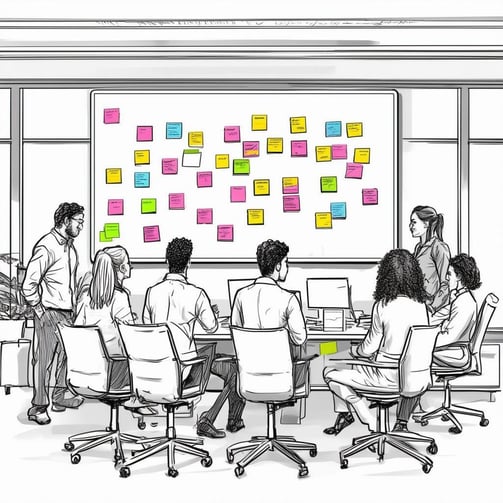
Indecision isn’t just a delay. It’s a silent deal-killer. B2B sales teams spend weeks, if not months, educating buyers, navigating stakeholder groups, and customizing proposals. And then everything stalls. The buyer stops replying. Budget discussions fade. Consensus weakens. There is no formal “no,” but no progress either.
This pattern isn’t rare. Research from Harvard Business Review shows that 40–60% of B2B deals end with no decision at all. This is not because the buyer found a better option but because they couldn’t align internally or overcome their fear of risk.
Indecision is more than frustrating for growth leaders. It’s expensive. And it’s preventable.

Modern B2B purchases are complex. B2B buyers do not act alone. Multiple stakeholders form decision groups. Within this decision group, each person faces different needs and pressures. When decisions stall, it’s often for one of three reasons:
These aren’t sales objections in the traditional sense. They’re psychological blockers. And no feature list or price incentive can move a deal forward if the buyer is unsure, fearful, or confused.
To combat indecision, messaging must shift from product-focused to decision-focused. This is where buyer-centric messaging becomes a revenue driver.
The goal is simple. Remove friction, clarify value, and frame action to make it easier for the buyer to say yes.
Most messaging focuses on benefits. But stalled buyers often need to hear the opposite: What happens if we do nothing?
Messaging that articulates the cost of the status quo creates urgency without pressure. Missed revenue, operational inefficiency, or security risks underscore the need to act.
For example:
“Every month you delay implementing X, your team loses an average of 200 hours to manual processes. That’s two full-time roles doing work automation could solve.”
This reframes the buying decision as a risk mitigation move instead of a new initiative.
Indecision often comes from a fear of choosing wrong. Strategic messaging can alleviate that by emphasizing the following:
One of the most powerful techniques is positioning your offer as a low-risk step toward a larger goal:
“Rather than committing to a full platform rollout, most clients start with one high-impact workflow. That way, you see measurable value in 60 days and build internal momentum.”
This helps buyers feel safer taking the first step, even if they’re not ready to commit fully.
When messaging focuses on features or tools, buyers default to comparing vendors. This leads to commodity thinking and fuels paralysis.
Instead, position the solution as part of a strategic transformation that aligns with the buyer’s larger goals:
“This isn’t just about implementing software—it’s about enabling your operations team to cut cycle times by 30% while improving compliance. That shift is what gives your business a competitive edge next year.”
Messaging like this gives internal champions something more compelling to present to their stakeholders. You’re not selling a product. You’re helping the buyer justify a change.
This approach isn’t just for top-of-funnel marketing. It’s critical during active deal conversations.
When sales teams are equipped with messaging frameworks, transformation plans, and business case content relative to key buyer roles, they can:
One of the most underused assets in B2B sales today is transformation content. Transformation content that shows what change looks like across phases, including measurable wins and anticipated challenges.
Sales shouldn’t rely solely on decks and demos. Strategic messaging tools like obstacle pathway briefs, challenger case stories, and frictionless rollout plans can create velocity in the mid-to-late funnel.
In long-cycle B2B sales, indecision is the enemy of revenue. But it’s not inevitable. The right messaging strategy can reduce the friction that stalls deals.
By shifting from features to outcomes, from options to confidence, and from selling to guiding, companies can turn messaging into a decision accelerator, reclaiming the pipeline that gets stuck in “maybe.”
Sources
Harvard Business Review, Stop Losing Sales to Customer Indecision, 2022
by Jonathan Franchell, CEO of Ironpaper - For more tips and hacks: Need to remove a new line after h1 tags? Both web designers and SEO practitioners need to employ headline tags: H1, H2, H3 in several ways to improve web page structure and tag...

The marketing industry is transforming significantly due to generative AI and increasing market complexity. Gartner's prediction of a 25% decline in traditional search traffic suggests that the era of search engines is dying. AI tools, particularly...

The Crowded Arena of the IT Marketplace Updated December 2024 The Information Technology (IT) landscape is experiencing rapid growth and intensifying competition. IT spending is projected to reach nearly 5.1 trillion U.S. dollars in 2024, a...

Updated December, 2024 The field of digital marketing is evolving rapidly in response to new technology and changing buyer expectations. To help career-minded marketers, we’ve rounded up the top 10 skills needed to succeed in the field. These are...
